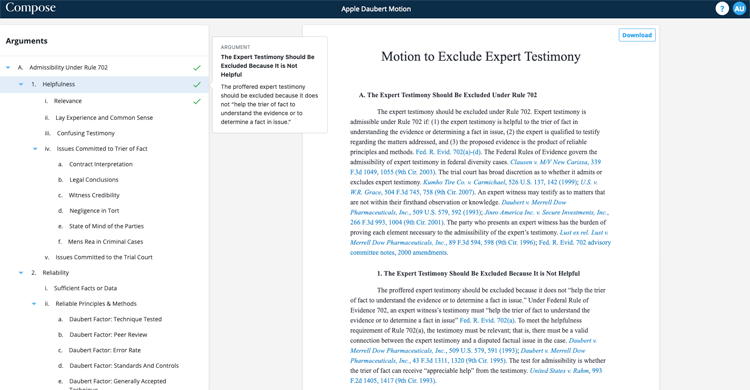Casetext launches automated brief-writing product

Image from Shutterstock
Casetext has developed an automated legal-writing product that purports to create an entire document with just a few simple clicks of the mouse.
The technology called Compose, which publicly launched today, automates the first draft of a legal brief or motion, dramatically reducing the hours attorneys need to spend producing a motion, according to San Francisco-based Casetext.
Casetext CEO and co-founder Jake Heller says he used Compose to draft a real 20-page motion in less than 30 minutes. He estimates the task would have taken anywhere from five to 10 hours without the technology, and notes other motions can take 80-plus hours without the use of Compose.
“It both reduces the amount of time it takes to write a brief and it makes the amount of time predictable because you don’t have to go down research black holes,” Heller says of the new technology.

Photo of Jake Heller provided by Casetext.
Heller recently gave the ABA Journal a demonstration of how the product, which Casetext believes is the first of its kind, works.
The user begins by selecting the type of document they want to draft. In the demo, Heller chose a motion to exclude expert witness testimony. Next, an attorney would select the district where their case is being litigated.
Once those two initial steps are taken, Compose generates a list of arguments a lawyer could make to support their motion.
For the demonstration, Heller chose to argue the expert testimony should be excluded under federal Rule of Evidence 702. He did so with a simple click. Sub-argument options included asserting that the expert testimony is not helpful because it covers topics within the lay understanding of jurors or arguing that the testimony was beyond the qualifications of the expert.
Heller says the quick generation of the argument list is a marked contrast to a process that normally requires time-consuming ad-hoc research on a case law database.
“The argument list makes you feel like you are at a French patisserie and going like, ‘I want one of those, one of those and one of those,’” Heller says. “It is as easy as that.”
A lawyer using Compose would go from selecting the arguments to determining which legal standards should be applied to the issues in play. This feature is called “tailored standards” because the options provided are specific to the jurisdiction where a case is being litigated. The cases presented for possible citation highlight key excerpts and indicate whether a case would favor the position of the lawyer’s client or that of the other side.
In addition to reviewing the cases Compose lists as relevant, an attorney can type in language they plan to use in their brief. A technology called Parallel Search then generates relevant cases based on the new sentences through the use of a “transformer-based neural language model.”
“What is amazing about Parallel Search is it looks beyond the actual words you use and finds cases that are on the same concept,” Heller says.

This screenshot of a brief being worked on in Compose was provided by Casetext.
Compose is also backed by Casetext’s existing legal research system that features its CARA artificial intelligence technology, allowing subscribers to click on a case in Compose that they want to examine in greater depth. (Heller and two others at Casetext, Co-founder Pablo Arredondo and Chief Operating Officer/General Counsel Laura Safdie, were named Legal Rebels by the ABA Journal in 2017.)
Once a lawyer has finished choosing the cases they plan to cite, they can click on the download option to get a first draft of their document in Microsoft Word. The time saved in producing a first draft enables law firms to spend more time improving the final product and allows them to charge their clients less, Heller says.
“We believe that the work is not just more efficient, it’s also a level more creative and a level more imaginative,” he says.
Casetext says several large firms have already embraced the technology. They include Bowman and Brooke; Ogletree, Deakins, Nash, Smoak & Stewart; and Sheppard, Mullin, Richter & Hampton.
Ali Shahidi, Sheppard Mullin’s chief innovation & client solutions officer, says his firm will roll out use of the product in the near future. The feedback he received from attorneys who have seen Compose in action is that it will save them significant time in completing various types of motions, potentially paving the way for clients to be served at a lower price point.
“The other benefit we see is it will create a consistent output,” Shahidi says. “The end result is the legal work product will always be complete from a legal argument perspective.”
Additionally, Shahidi says his firm anticipates using Compose as a training tool.
“In effect, you are capturing the knowledge of attorneys with years of experience and making that readily available to new associates,” he says. “We expect that will be a great benefit to both the firm and our clients.”



